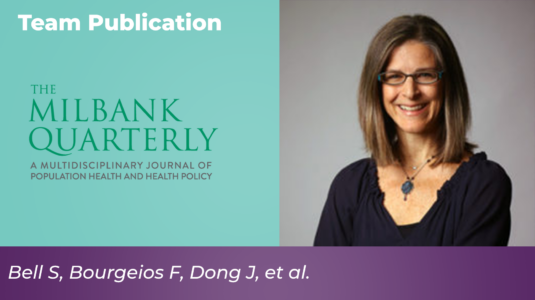A new study from OpenNotes shows patients and families who read open notes hold unique insights and can catch potential safety hazards that are difficult for clinicians or organizations to see.
Bourgeois, Fabienne
Attitudes, experiences, and safety behaviours of adolescents and young adults who read visit notes: Opportunities to engage patients early in their care
Today’s adolescents and young adults have grown up immersed in technology, but their interest in and benefit from reading their care notes online is not well understood. In our study, the majority of AYA read notes and rated them as extremely important for several engagement and safety behaviours. Although a similar proportion of AYA reported definite or possible errors in their notes as adults, fewer spoke up about them, citing knowledge and cultural barriers like fear of conflict. Taken together, these findings support initiatives that encourage AYA to read notes and share concerns. Efforts that include note-reading may help transition patients from paediatric to adult care with greater autonomy, activation and safety partnership.
Filling a gap in safety metrics: development of a patient-centred framework to identify and categorise patient-reported breakdowns related to the diagnostic process in ambulatory care
The PRDB framework, developed in partnership with patients/families, can help organisations identify and reliably categorise PRDBs, including some that are invisible to clinicians; guide interventions to engage patients and families as diagnostic partners; and inform whole organisational learning.
Co-development of OurDX—an online tool to facilitate patient and family engagement in the diagnostic process
Patients and their care partners are usually the first to notice new or changing symptoms and are the connecting “thread” between different healthcare encounters. In this article Sigall Bell, Fabienne Bourgeois, Stephen Liu, and Eric Thomas—along with patient partners Betsy Lowe and Liz Salmi—describe the co-development of an online tool called “OurDX” (Our Diagnosis) to engage patients and families in the diagnostic process
Speaking up about patient-perceived serious visit note errors: Patient and family experiences and recommendations.
About half of patients and families who perceived a serious mistake in their notes reported it. Identified barriers demonstrate modifiable issues such as establishing clear mechanisms for reporting and more challenging issues such as creating a supportive culture. Respondents offered new ideas for engaging patients and families in improving note accuracy.
Preserving privacy for pediatric patients and families: use of confidential note types in pediatric ambulatory care
Our data demonstrate variability in the use of a confidential note type across specialties, patient ages, and types of confidential information. This note type is frequently utilized by a subset of providers who often manage sensitive patient and parent information. As vendors and institutions enable open notes, thoughtful implementation and provider education surrounding the use of this confidential feature is needed.
A patient and family reporting system for perceived ambulatory note mistakes: experience at 3 U.S. healthcare centers
Partnering with patients and families to obtain reports on inaccuracies in visit notes may contribute to safer care. Mechanisms to encourage greater use of patient and family reporting systems are needed.
OpenNotes: Toward a Participatory Pediatric Health System
OpenNotes’ magic lies within the simple act of empowering patients and their family members to have access to their full medical information so that they can participate in their care (Fig 1). Providing access to clinical documentation in addition to the laboratory test results and reports in a patient portal helps to synthesize information and provide context. The notes are a vital component for multiple caretakers to better keep track of their children’s health care needs and for parents to better coordinate care for their child with medical complexity. Adolescent patients should be invited to participate by having access to their notes, with the necessary privacy controls in place, to prepare and empower them toward the goal of eventually taking full responsibility of their own health care. Pediatric and informatics leaders need to advocate for and work together with electronic health record vendors to help shape patient portals to thoughtfully support OpenNotes for the child and adolescent populations. Ultimately, moving toward a participatory pediatric health system will require more than design, technology, and policy changes; it will require a broader shift in culture.
The Importance of Visit Notes on Patient Portals for Engaging Less Educated or Nonwhite Patients: Survey Study
Less educated and nonwhite patients using the portal each assigned higher importance to reading notes for several health behaviors than highly educated and white patients, and may find transparent notes especially valuable for understanding their health and engaging in their care. Facilitating access to notes may improve engagement in health care for some vulnerable populations who have historically been more challenging to reach.
Tackling Ambulatory Safety Risks Through Patient Engagement: What 10,000 Patients and Families Say About Safety-Related Knowledge, Behaviors, and Attitudes After Reading Visit Notes
Background: Ambulatory safety risks including delayed diagnoses or missed abnormal test results are difficult for clinicians to see, because they often occur in the space between visits. Experts advocate greater patient engagement to improve safety, but strategies are limited. Patient access to clinical notes (“OpenNotes”) may help close the safety gap between visits.
Methods: We surveyed patients and families who logged on to the patient portal and had at least one ambulatory note available in the past 12 months at two academic hospitals during June to September 2016, focusing on patient-reported effects of OpenNotes on safety knowledge, behaviors, and attitudes.




